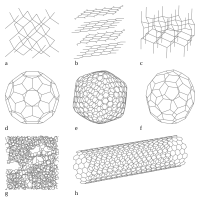
Photo from wikipedia
Porous carbons, possessing exceptional stability, high surface area, and electric conductivity, are broadly used as superior adsorbent, supporter, or electrode material for environmental protection, industrial catalysis, and energy storage and… Click to show full abstract
Porous carbons, possessing exceptional stability, high surface area, and electric conductivity, are broadly used as superior adsorbent, supporter, or electrode material for environmental protection, industrial catalysis, and energy storage and conversion. The construction of such kinds of materials with designable structures and properties will extremely extend their potential applications, but remains a huge synthetic challenge. Herein, a bottom‐up approach is presented to synthesize one type of fully sp2 carbon–bonded frameworks by transition metal–catalyzed cross‐coupling of different polyphenylenes with electron‐withdrawing 9,9′‐bifluorenylidene (9,9′‐BF) through its 2,7‐position. The resulting porous polymeric carbons exhibit substantial semiconducting properties, such as strong light‐harvesting capabilities in the visible light region, likely due to their π‐extended backbones with donor–acceptor characters. Their electronic and porous structures can be finely tuned via the polyphenylene spacers. The intriguing properties allow these porous carbons to efficiently catalyze dye degradation under visible light or even natural sunlight with high reusability. Meanwhile, associated with their intrinsic structures, these porous carbons also exhibit highly selective degradation activities toward different dyes. In particular, the photodegradation mechanism involving oxygen and electron is elucidated for the first time for such kinds of materials, related to the presence of specific 9,9′‐BF units in their π‐conjugated skeletons.
Journal Title: Advanced Functional Materials
Year Published: 2019
Link to full text (if available)
Share on Social Media: Sign Up to like & get
recommendations!